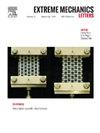Layer-jamming soft gripper for improved stiffness control and underwater adhesion
IF 4.5
3区 工程技术
Q2 MATERIALS SCIENCE, MULTIDISCIPLINARY
引用次数: 0
Abstract
Soft robotic grippers have attracted significant attention due to their lightweight, simple structures, and versatile applications. Especially, soft suction cups (SSCs) are generally used for their low energy consumption and a high lifting ratio. However, they encounter challenges for mitigating a trade-off between conformability and adhesion performance and applications for the wet conditions. This paper introduces the layer-jamming soft gripper (LJSG), a novel design that significantly enhances adhesion while maintaining adaptive conformability and demonstrates effective underwater adhesion. Notably, the LJSG is resistant to hydraulic leakage due to a protective membrane attached to its body. Additionally, our design concurrently enhances adhesion capability with layer-jamming mechanism compared to conventional SSCs and mitigates the impact of unjammed layers on conformability by incorporating an interval to reduce required preload for interfacial adaptation. These features collectively enable the LJSG to demonstrate reliable performance in grasping diverse objects underwater. We elucidate the layer-jamming mechanism and demonstrate how jammed layers enhance maximum pull-off force by analytical method, numerical method, and experiments. The LJSG shows 300 % adhesion improvement than previous SSCs via the experiments, while 290 % from the analytical method and 245 % from the numerical method. The experiments also demonstrate that LJSG has an enhanced capability for gripping curved objects. This design can be applicable for grasping objects regardless of their curvatures and sizes. Hence, these findings underscore LJSG’s potential for diverse applications, particularly in challenging underwater environments, and position it as a viable solution for adaptive, high-performance soft robotic adhesion.
层卡软夹具,改善刚度控制和水下附着力
机器人软爪以其重量轻、结构简单、用途广泛而备受关注。特别是软吸盘(ssc)由于其低能耗和高提升比而被广泛使用。然而,它们面临的挑战是如何减轻相容性和粘附性能之间的权衡,以及在潮湿条件下的应用。本文介绍了一种新颖的层卡软夹持器(LJSG),它在保持自适应顺应性的同时显著增强了附着力,并展示了有效的水下附着力。值得注意的是,LJSG具有抗液压泄漏的能力,因为它的身体上附着了一层保护膜。此外,与传统ssc相比,我们的设计同时增强了层卡机制的粘附能力,并通过加入间隔来减少界面适应所需的预载荷,减轻了未卡层对相容性的影响。这些特点共同使LJSG在水下捕捉各种物体时表现出可靠的性能。通过解析法、数值法和实验,阐明了层间的干扰机制,并论证了被干扰的层间如何提高最大拉脱力。实验结果表明,LJSG的粘接性能比以往的ssc提高了300 %,比解析法提高了290 %,比数值法提高了245 %。实验还表明,LJSG对弯曲物体的抓取能力有所提高。这种设计可以适用于抓取物体,无论其曲率和大小。因此,这些发现强调了LJSG的多种应用潜力,特别是在具有挑战性的水下环境中,并将其定位为自适应、高性能软机器人粘附的可行解决方案。
本文章由计算机程序翻译,如有差异,请以英文原文为准。
求助全文
约1分钟内获得全文
求助全文
来源期刊

Extreme Mechanics Letters
Engineering-Mechanics of Materials
CiteScore
9.20
自引率
4.30%
发文量
179
审稿时长
45 days
期刊介绍:
Extreme Mechanics Letters (EML) enables rapid communication of research that highlights the role of mechanics in multi-disciplinary areas across materials science, physics, chemistry, biology, medicine and engineering. Emphasis is on the impact, depth and originality of new concepts, methods and observations at the forefront of applied sciences.
 求助内容:
求助内容: 应助结果提醒方式:
应助结果提醒方式:


